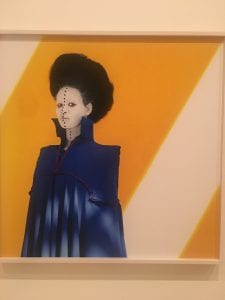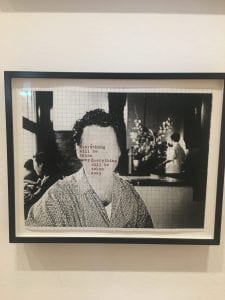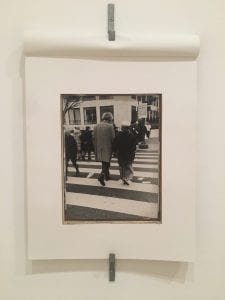As I stepped into the third floor exhibition room, my eyes were instantly drawn to Aïda Muluneh’s vibrant photographs. In this specific photograph, Muluneh uses line, framing, and color to enhance her theme and create a visually appealing picture. The lines in the background, for example, draw the viewers’ gaze towards the subject, making her presence in the photograph especially proud and prominent. In addition, her subject is uncentered and follows the rule of thirds. Muluneh’s inspiration comes from the stereotypical depictions of Africans/ African Americans in the mass media. She strives to capture Africans/ African Americans bearing face paint; face painting is a worldwide practice and has several stylistic commonalities around the globe. This is meant to give viewers the chance NOT to racially profile, but to appreciate the photograph and remember it by more than just race. In this photograph, Muluneh’s use of color is incredibly interesting and engaging. I believe she only features primary colors because primary colors are universal, and she does not want any color to be associated with a particular race. Her choice to use warm colors in the back, and cool colors in the front is also striking. Cool colors recede, and warm colors come forward. By making the photographs MAIN subject wear blue, Muluneh is juxtaposing the topic of race and color: the issue of race, which is usually pushed back, is literally coming forward.
What first drew me to this photograph was the fact that it reminded me of John Baldessari’s work: the photographs were clearly posed and the subjects’ faces were purposely obscured, which is the focus and statement made by this work. I believe its composition and thematic elements make it a strong collection. The effect of the photo is jarring because it contrasts traditional rules of portrait photography, like the rule of thirds and depth of field, with the deliberate erasing of the subjects faces (replaced by text). This non-traditional element helps engage the audience and reinforce the pieces’ theme: that we are not permanent. The text reads “everything will be taken away,” conveying the idea that individuals perish. The removal of the face illustrates the theme because it demonstrates that people are “taken away” from this earth: erased from the environments that defined them. The photographs are less about the people posing than the statement being made about the impermanence of human existence. The graph paper used suggests precision, structure, and hardness, all of which feel detached, dispassionate, and statement-making. This sense of detachment allows viewers to focus on the message of how fleeting peoples’ lives are, and how quickly they will be replaced. The fact that the photos appear to be vintage makes the subjects seem ghost-like and suggests that they may have already gone; their faces are no longer relevant because life is ephemeral.
Em Rooney’s creative presentations emphasize her photography’s strongest compositional elements, which is why I was so drawn to her work. This photograph, for example, has repeated vertical rectangles throughout. Each is repeated in groups of three; this is incredibly successful because groups of three are natural and most comfortable to the eye. The groupings make the photograph aesthetically pleasing, and this is stressed by the frame, which is also rectangular. The photographs main subject is clear, but the lines in the photograph don’t allow viewers to linger there. The lines draw viewers outside the photograph and into the frame; this is successful because the photographs main subject is not too interesting, and this forces the eye to travel. The lines of the crosswalk almost seem to continue moving into the surrounding frame, since both are a striking, clean shade of white. Rooney aims to create unconventional frames for her photographs. Each frame refers to a specific individual; there is a nostalgic-like quality to the photograph and this is emphasized by the fact that the photo is black and white.



Leave a comment